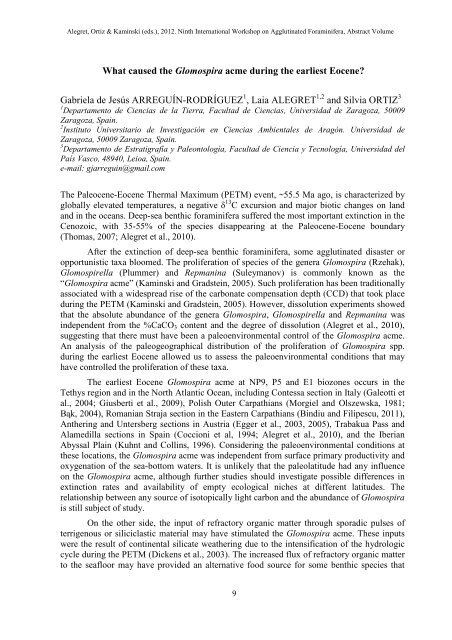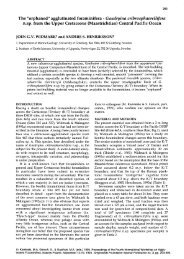Full Text | Download - Grzybowski Foundation - The ...
Full Text | Download - Grzybowski Foundation - The ...
Full Text | Download - Grzybowski Foundation - The ...
You also want an ePaper? Increase the reach of your titles
YUMPU automatically turns print PDFs into web optimized ePapers that Google loves.
Alegret, Ortiz & Kaminski (eds.), 2012. Ninth International Workshop on Agglutinated Foraminifera, Abstract Volume<br />
What caused the Glomospira acme during the earliest Eocene?<br />
Gabriela de Jesús ARREGUÍN-RODRÍGUEZ 1 , Laia ALEGRET 1,2 and Silvia ORTIZ 3<br />
1 Departamento de Ciencias de la Tierra, Facultad de Ciencias, Universidad de Zaragoza, 50009<br />
Zaragoza, Spain.<br />
2 Instituto Universitario de Investigación en Ciencias Ambientales de Aragón. Universidad de<br />
Zaragoza, 50009 Zaragoza, Spain.<br />
3 Departamento de Estratigrafía y Paleontología, Facultad de Ciencia y Tecnología, Universidad del<br />
País Vasco, 48940, Leioa, Spain.<br />
e-mail: gjarreguin@gmail.com<br />
<strong>The</strong> Paleocene-Eocene <strong>The</strong>rmal Maximum (PETM) event, ~55.5 Ma ago, is characterized by<br />
globally elevated temperatures, a negative δ 13 C excursion and major biotic changes on land<br />
and in the oceans. Deep-sea benthic foraminifera suffered the most important extinction in the<br />
Cenozoic, with 35-55% of the species disappearing at the Paleocene-Eocene boundary<br />
(Thomas, 2007; Alegret et al., 2010).<br />
After the extinction of deep-sea benthic foraminifera, some agglutinated disaster or<br />
opportunistic taxa bloomed. <strong>The</strong> proliferation of species of the genera Glomospira (Rzehak),<br />
Glomospirella (Plummer) and Repmanina (Suleymanov) is commonly known as the<br />
“Glomospira acme” (Kaminski and Gradstein, 2005). Such proliferation has been traditionally<br />
associated with a widespread rise of the carbonate compensation depth (CCD) that took place<br />
during the PETM (Kaminski and Gradstein, 2005). However, dissolution experiments showed<br />
that the absolute abundance of the genera Glomospira, Glomospirella and Repmanina was<br />
independent from the %CaCO3 content and the degree of dissolution (Alegret et al., 2010),<br />
suggesting that there must have been a paleoenvironmental control of the Glomospira acme.<br />
An analysis of the paleogeographical distribution of the proliferation of Glomospira spp.<br />
during the earliest Eocene allowed us to assess the paleoenvironmental conditions that may<br />
have controlled the proliferation of these taxa.<br />
<strong>The</strong> earliest Eocene Glomospira acme at NP9, P5 and E1 biozones occurs in the<br />
Tethys region and in the North Atlantic Ocean, including Contessa section in Italy (Galeotti et<br />
al., 2004; Giusberti et al., 2009), Polish Outer Carpathians (Morgiel and Olszewska, 1981;<br />
Bąk, 2004), Romanian Straja section in the Eastern Carpathians (Bindiu and Filipescu, 2011),<br />
Anthering and Untersberg sections in Austria (Egger et al., 2003, 2005), Trabakua Pass and<br />
Alamedilla sections in Spain (Coccioni et al, 1994; Alegret et al., 2010), and the Iberian<br />
Abyssal Plain (Kuhnt and Collins, 1996). Considering the paleoenvironmental conditions at<br />
these locations, the Glomospira acme was independent from surface primary productivity and<br />
oxygenation of the sea-bottom waters. It is unlikely that the paleolatitude had any influence<br />
on the Glomospira acme, although further studies should investigate possible differences in<br />
extinction rates and availability of empty ecological niches at different latitudes. <strong>The</strong><br />
relationship between any source of isotopically light carbon and the abundance of Glomospira<br />
is still subject of study.<br />
On the other side, the input of refractory organic matter through sporadic pulses of<br />
terrigenous or siliciclastic material may have stimulated the Glomospira acme. <strong>The</strong>se inputs<br />
were the result of continental silicate weathering due to the intensification of the hydrologic<br />
cycle during the PETM (Dickens et al., 2003). <strong>The</strong> increased flux of refractory organic matter<br />
to the seafloor may have provided an alternative food source for some benthic species that<br />
9



